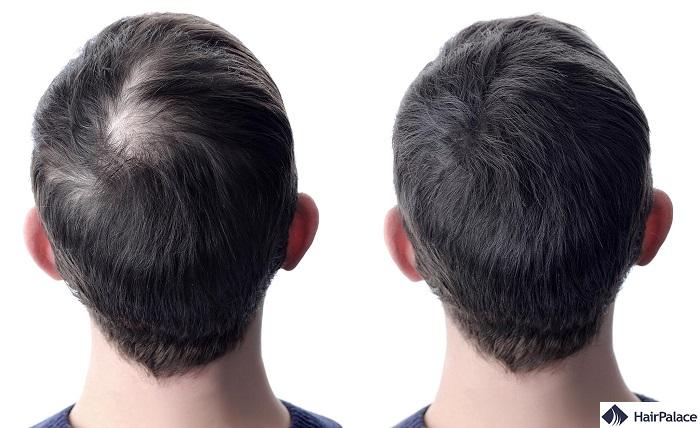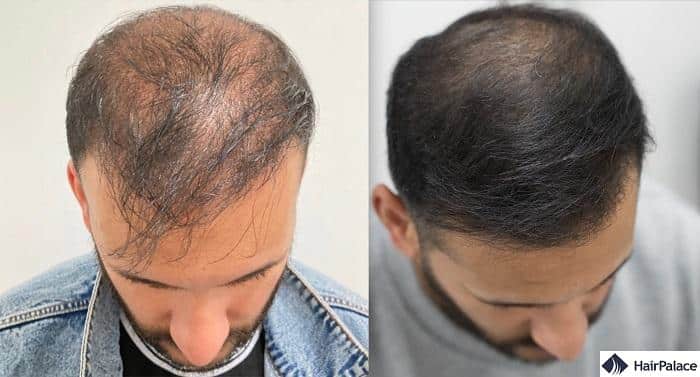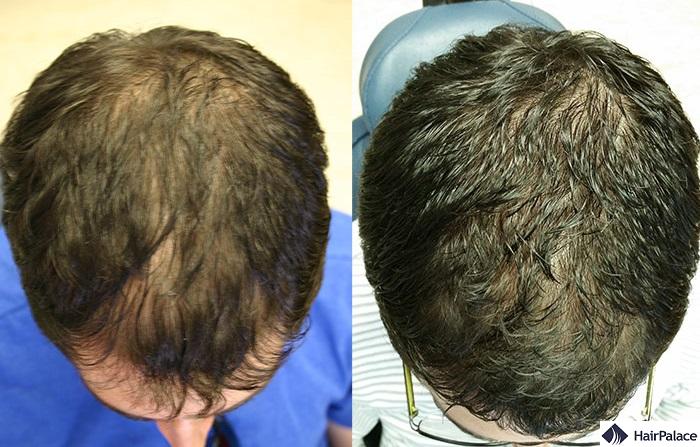Laser Treatment for Hair Loss: Procedure, Benefits & Alternatives
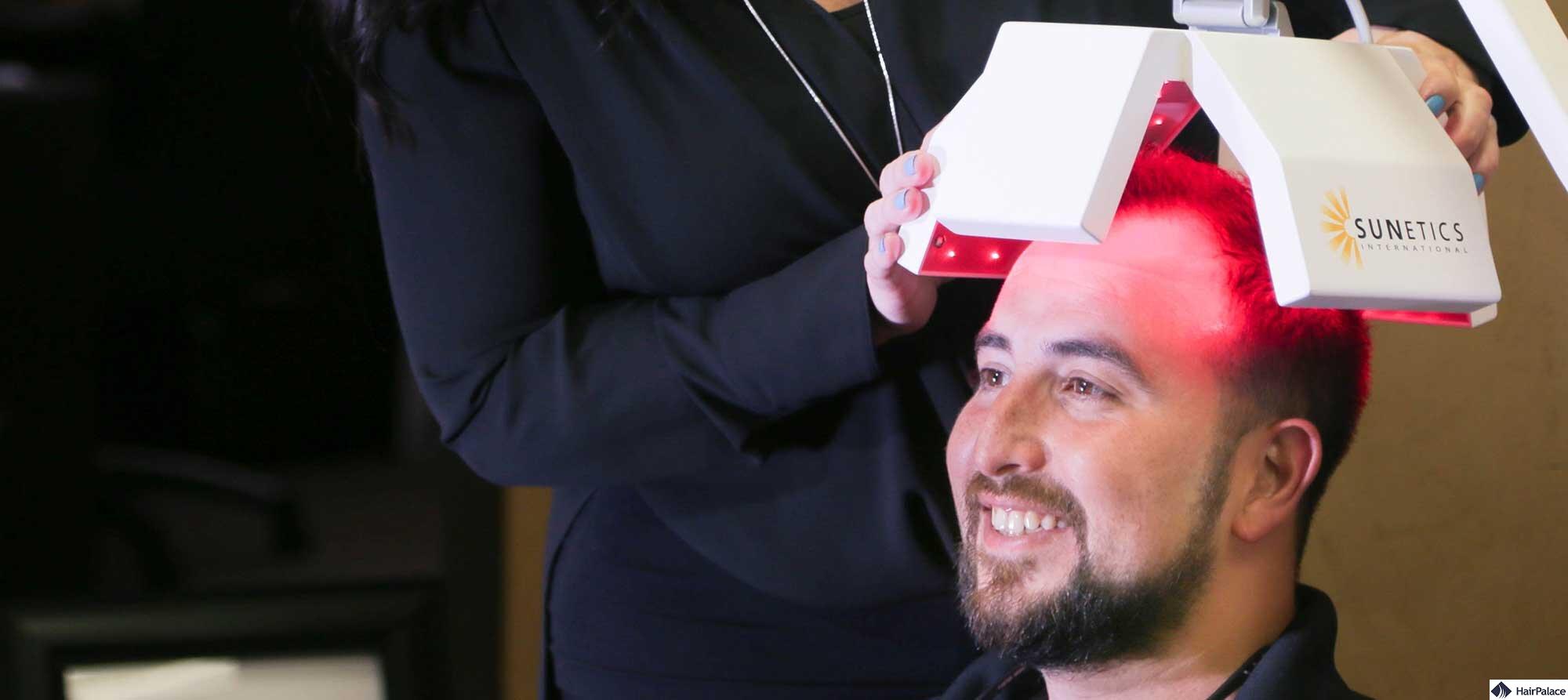
- About hair loss
- How it works
- Types of treatments
- Before and after
- Alternatives
- Benefits
- Drawbacks
- Cost
- Takeaway
- FAQ
Laser treatment for hair loss, also known as low-level laser therapy (LLLT), involves using red or near-infrared light to stimulate hair follicles and promote hair growth.
It increases blood flow to the scalp, encourages cellular activity, and can improve hair density and thickness.
Thanks to its non-invasive nature, it can suit many patients who might not qualify for surgery.
This article will take an in-depth look at how low-level laser hair loss treatments work.
We will see if they can treat male and female pattern hair loss and recommend alternative therapies for your hair recovery.
About hair loss
Hair loss has become quite a common ailment nowadays. Many experts cite people’s rising stress levels and bad dietary choices as huge contributing factors.
Hair loss affects both men and women, although male pattern baldness is much more common than the female equivalent.
Our diagram below shows that by age 50, up to 60% of men will have experienced some degree of hair loss. For women, the statistics show up to 50% will experience it in their lifetime.
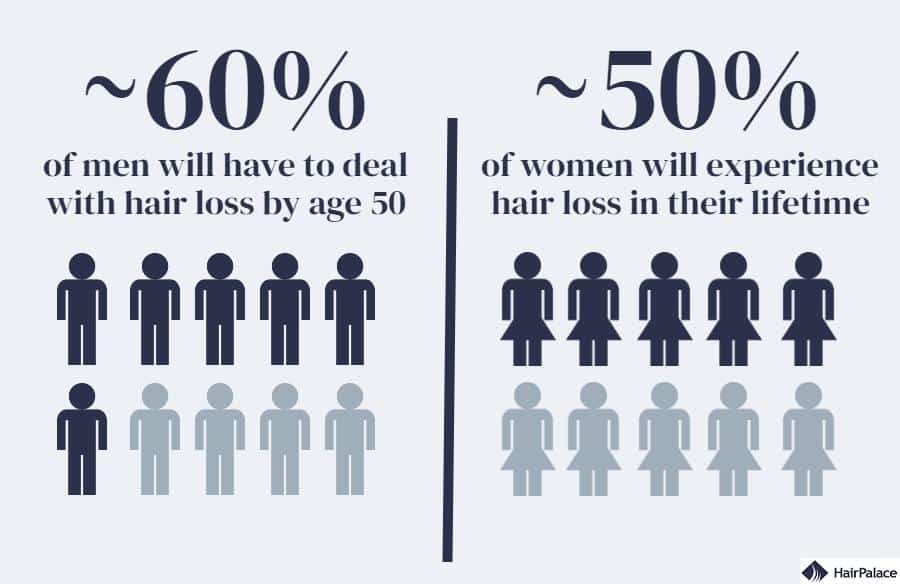
From this, we can safely say that men tend to experience more severe cases of balding at a younger age than women.
So what are the leading causes of thinning hair for men and women?
- Genetics – Hereditary hair loss is the most common in both men and women, and sadly there is not much you can do to prevent it. If someone in your family has experienced hair loss, this points that you will most likely follow suit.
- Hormonal imbalance – Any change in hormones in your body can disrupt and alter your hair’s natural growth rate. A shortened growth period results in shorter, lighter hair that is much more brittle and prone to falling out.
- Environmental factors – Severe stress can push hair follicles into a dormant phase, weakening strands to the point that they fall out early. Your body also needs protein to produce healthy hair – malnutrition and vitamin deficiencies can result in thinning hair.
How does it work?
Specialists have developed several highly advanced treatments to help counteract the considerable surge in hair loss worldwide.
Laser hair growth therapy is fast becoming a popular option, as it is safe, non-invasive, and more affordable than other options.
It works through a process called photochemical hair growth stimulation.
That’s a fancy way of saying the light rebalances biochemical processes in your scalp. Blood flow is increased, and inflammation is decreased.
Irradiating photons are sent directly into scalp tissue and absorbed by weaker cells. This promotes increased hair growth in areas of your scalp prone to thinning hair.
Depending on the clinic, this treatment may be called either red light or cold laser hair therapy.
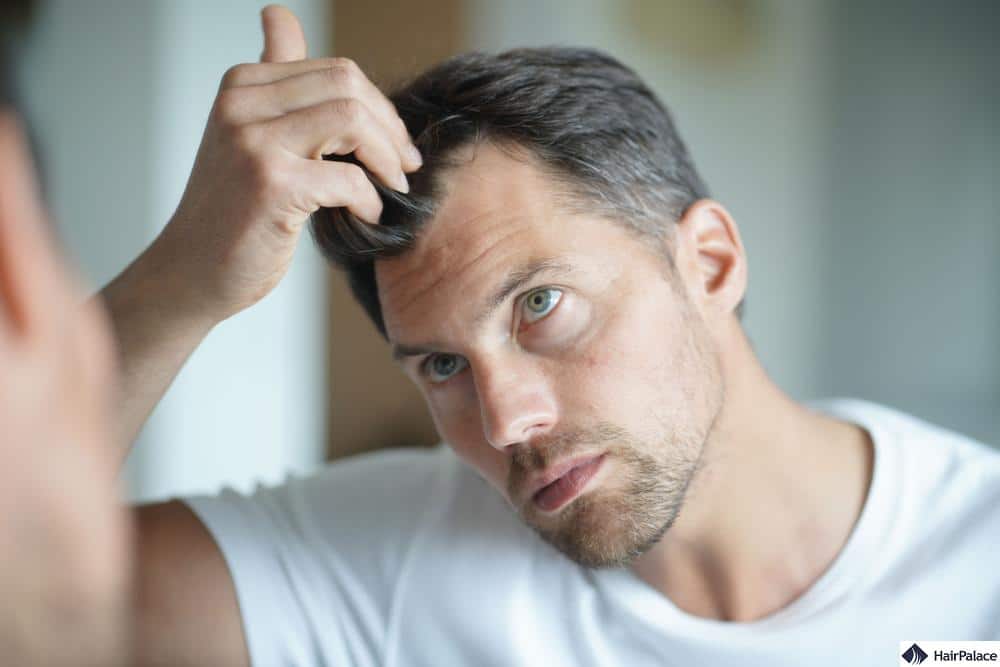
Is laser hair therapy for hair loss effective?
A lack of definitive scientific research means we cannot say for absolute certainty that laser hair growth therapy cures hair loss.
The only evidence we have available is purely anecdotal. The treatment works for some people and not for others.
Some studies conducted in 2013 and 2014 have shed some light on the treatment. E.g.
- A 2013 study examining human scalp hair mediated by laser lights found that 39% of men experienced increased hair density over 16 weeks.
- A 2014 study found low-level laser light therapy concluded the treatment was safe and had some influence on a hair’s growth period.
Types of laser treatment for hair loss:
The two most popular low-level light therapy treatments include:
Laser caps and combs
Laser caps and combs are an effective way to combat thinning hair in a casual, comfortable way.
They emit red light, gently stimulating hair follicles over time. They are most effective when treating the early stages of hair thinning.
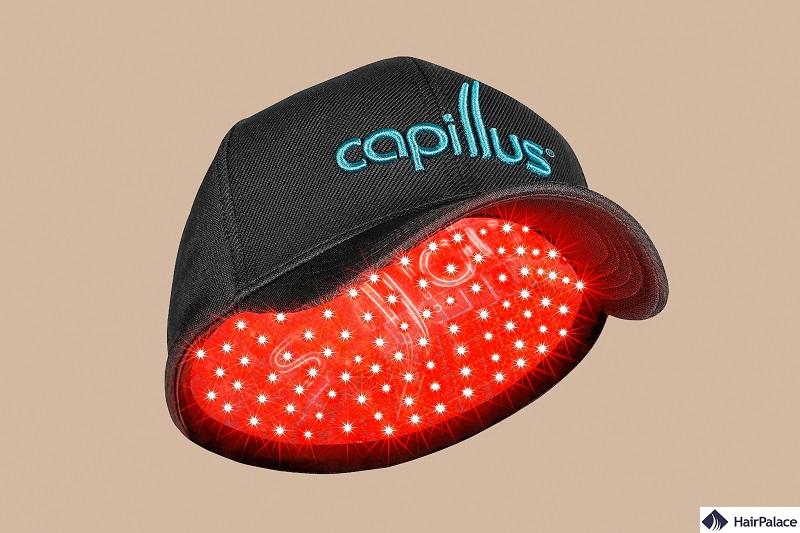
One of the main advantages of using a laser cap or comb is that they are portable – you can wear them anywhere!
Because of their clever design, these accessories can be worn without feeling self-conscious.
Typically, patients wear them for at least 15 minutes daily to yield the best results possible.
Low-level laser therapy
This therapy best suits patients currently in the early stages of hair loss.
Unlike a laser cap, it’s not as portable, and you may have to attend in-person clinic appointments or sit still while receiving the treatment.
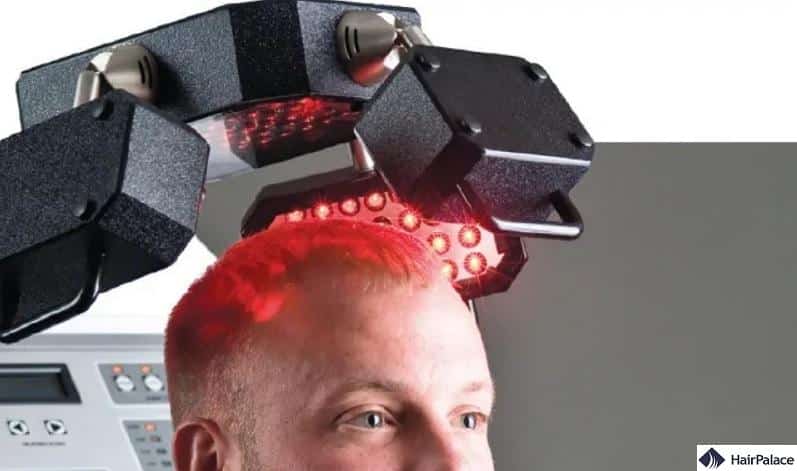
You will likely undergo this therapy at least 5-10 times every two weeks, with results appearing after the 5th treatment.
Laser therapy for hair loss before and after
Alternatives to laser hair therapy
Hair loss specialists may recommend other treatments to counteract female and male hair loss. They are:
Medication
Medication can effectively promote new hair growth but does not offer a permanent solution. Once you stop taking them, your hair will return to its previous state.
Medicines may also produce side effects that some patients can be uncomfortable with.
The two main medications prescribed are:
- Finasteride is used to reduce the amount of DHT produced in the body in the case of male androgenetic alopecia. DHT is a hormone that negatively affects the hair growth rate on your scalp.
- Minoxidil (also known as rogaine) can be used as a topical treatment to restore texture, stimulate hair regrowth, and replenish hair follicles.
Hair transplants
Hair transplant surgery is currently the only permeant solution to combating male pattern hair loss.
It works by redistributing hair from dense parts of your scalp (usually the back and sides) to areas in need of new hair growth.
There are, of course, downsides to this treatment. Hair transplantation can be costly and, depending on the surgery type, can be more invasive than other treatment options.
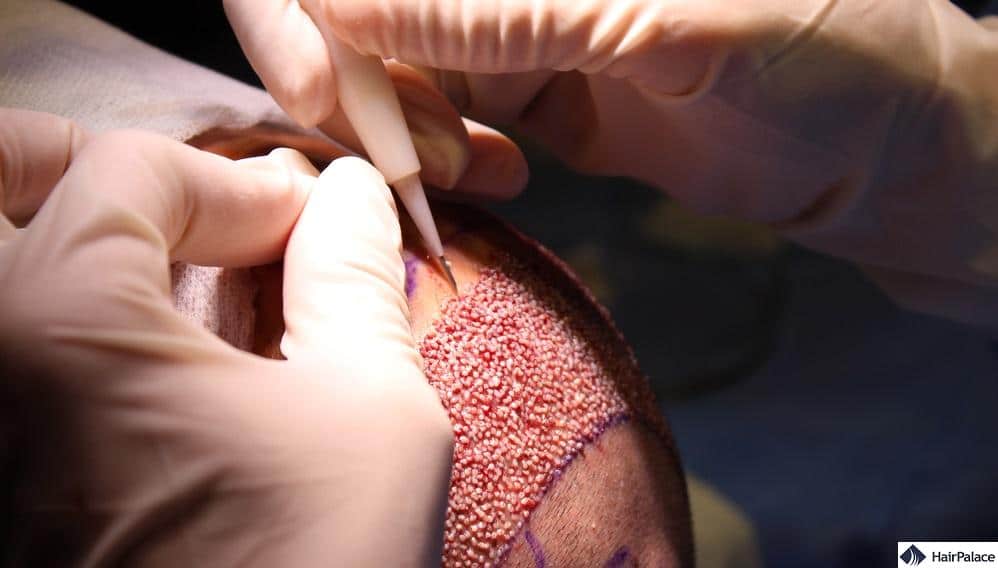
What are the pros?
Red light therapy has several advantages over other hair restoration treatments, which makes it a preferred choice for many patients.
These include:
- Painless: patients experience no discomfort when receiving treatment.
- Non-invasive: There are no scars, marks, or signs of treatment.
- No side effects: Patients can undergo treatment worry-free!
- Improved appearance: Low level laser treatment can improve human scalp hair texture and strength, resulting in thicker hair.
What are the cons?
As with any medical treatment, there are some disadvantages to receiving laser scalp treatment for hair loss.
These include:
- Price: Patients often require several laser sessions for optimal results. Although treatment may seem cheap at £50, repeated sessions add up!
- Lengthy process: You need to be dedicated to get the best results. Patients will only see results by attending several sessions. Most clinics recommend treatment for life.
- Not for everyone: Laser therapy can be very effective for patients in the early stages of hair loss. It may have no little effect if you’re in an advanced state.
- Poorly regulated: Laser devices are classified as medical devices and may not go through the same quality controls and testing as medications.
- More research is needed: there’s still so much we don’t fully understand, especially concerning laser therapy. Only with more time will the industry know the long-term effects of laser therapy.
Laser therapy for hair loss cost
Costs can vary based on the type of device you choose, as well as the reputation of your clinic should you opt for professional low-level laser therapy instead of the at-home treatment.
Laser combs can range between £200-£500. laser bands are slightly more expensive and may cost around £600-£900 while laser caps may cost as much as £2000.
When it comes to professional treatment at a clinic prices can also be influenced by location, employee qualifications and the cost of living.
However, laser therapy for hair loss in the UK usually ranges between £45-£75 per treatment, and most clinics will advise you to attend at least 20-30 sessions.
This could bring your total cost somewhere between £900-£2250.
The takeaway on laser light treatment
Hair thinning can be a devastating condition for anyone to experience. But various treatments available can help restore your hair to its former glory.
But is laser therapy the right fit for you? Well, like any treatment, there are positives and negatives involved that you must consider.
Visible red light laser therapy is not a fully scientifically proven treatment just yet, though many industry professionals recognize its potential.
Ultimately, we recommend discussing your condition with your doctor, so you both can make an informed decision on the best course of action.
What other treatment options are available?
It’s not always easy to know which hair loss treatment is right for you. Let’s explore other recommended options!
- Biograft hair transplant
- Scalp micropigmentation
- PRP for hair loss
- Rogaine for hair loss
- Hair tattoo
- PRF treatment
- Topical Finasteride
FAQ
Low-level laser therapy can promote hair growth after four months of treatment. That said, results vary between patients.
No, laser therapies are not recognized as permeant hair loss treatments. The benefits will disappear once you stop regularly attending appointments or using any devices.
Anecdotally, laser devices have been known to improve the thickness and density of your hair. However, without extensive research, we cannot say with certainty how effective they can be.
Last medically reviewed on July 18th, 2024
- Afifi L, Maranda EL, Zarei M, Delcanto GM, Falto-Aizpurua L, Kluijfhout WP, Jimenez JJ. Low-level laser therapy as a treatment for androgenetic alopecia. Lasers Surg Med. 2017 Jan;49(1):27-39. doi: 10.1002/lsm.22512. Epub 2016 Apr 25. PMID: 27114071.
- Rose PT. Advances in Hair Restoration. Dermatol Clin. 2018 Jan;36(1):57-62. doi: 10.1016/j.det.2017.09.008. PMID: 29108547.
- McElwee KJ, Shapiro JS. Promising therapies for treating and/or preventing androgenic alopecia. Skin Therapy Lett. 2012 Jun;17(6):1-4. PMID: 22735503.
- Nazarian RS, Farberg AS, Hashim PW, Goldenberg G. Nonsurgical hair restoration treatment. Cutis. 2019 Jul;104(1):17-24. PMID: 31487342.
- Avci P, et al. (2013). Low-level laser (light) therapy (LLLT) for treatment of hair loss. DOIhttps://doi.org/10.1002/lsm.22170

